|
|
|
|
.
George Krambles (1915-1999)
|
|
|
|
.
George Krambles (1915-1999)
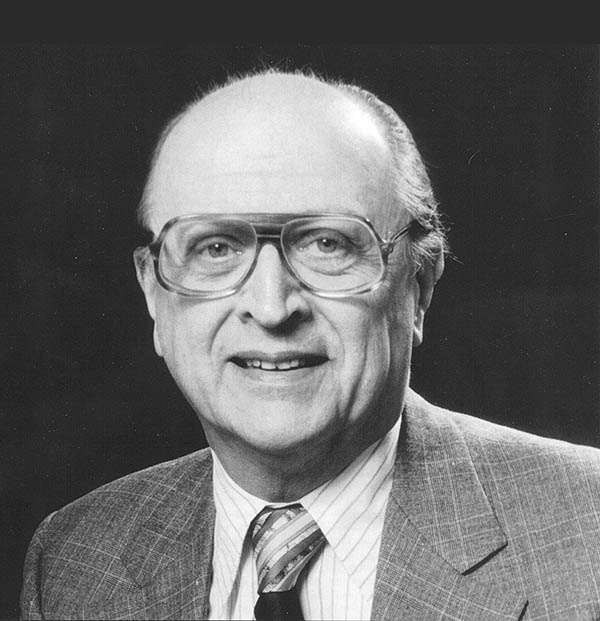 Few
men have single-handedly had the effect on a city's mass transit
system as George Krambles did on Chicago's rapid transit. Both a
transit professional and enthusiast, Krambles -- or "GK" as he was
called by close friends and relatives -- began working for the
Chicago Rapid Transit during the Depression, rising to become
executive director of the Chicago Transit Authority. His influence
can be felt not only in the "L" operations, rolling stock, and
infrastructure, but also in its railfan culture, academic literature,
and the education of young transit enthusiasts. He was truly a
renaissance man of the Chicago elevated.
Few
men have single-handedly had the effect on a city's mass transit
system as George Krambles did on Chicago's rapid transit. Both a
transit professional and enthusiast, Krambles -- or "GK" as he was
called by close friends and relatives -- began working for the
Chicago Rapid Transit during the Depression, rising to become
executive director of the Chicago Transit Authority. His influence
can be felt not only in the "L" operations, rolling stock, and
infrastructure, but also in its railfan culture, academic literature,
and the education of young transit enthusiasts. He was truly a
renaissance man of the Chicago elevated.
George Krambles was born on March 11, 1915 in Chicago. He traced the beginnings of his interest in railroads to a trip he made with his family to the West Coast in 1918. During a stay in Portland, OR, he saw both SP gas-electric trains and the "red electrics" of SP's Portland, Eugene & Eastern subsidiary. These made a lasting impression on him.
In 1936, Krambles began working for the Indiana Railroad, an intercity electric railway, after completing a degree in Railway Electrical Engineering from the University of Illinois at Champaign-Urbana. He was a management trainee (a position he persuaded the receiver of the Indiana Railroad to create) on a road that pioneered high performance passenger service using lightweight cars at speeds of 70 mph using one-man crews. After just a few months, he was assigned a number of duties in the car shop, including shifting cars around the yard. Krambles kept a log of his yard movements, perhaps with the goal of running every motorcar the interurban owned, conjectures First & Fastest editor Roy Benedict. It read like this: "12/5/36, shifted car 65. Shifted car 455. Shifted car 92..." And, proving even young George was anything but infallible, wrote in smaller handwriting, "Also derailed it."
 Junior engineer George Krambles works a wartime shift as a power supervisor in the CRT's Edison Building office in 1941. Click here for a larger view. (Photo from the Krambles-Peterson Archive ) |
It was also about this time that Krambles made one of many lasting contributions to the transit community. George was one of six fans that formed the Central Electric Railfans' Association, a group dedicated to the study of the history, equipment and operation of urban, suburban, interurban, and main line electric railways. As member #1, Krambles was also its first chairman and publication director. GK continued to contribute to CERA throughout his life, from trip organization to publication contributions. He even made one of his first contributions to the lexicon here: he coined the term "railfan" to refer to admirers of railroading. The term was typical of his lifelong passion to find ways to "reduce the bulk," a talent he would be able to fully demonstrate with the CTA. The CERA almost immediately began doing one of things it was most famous for: operating "fantrips", chartered train rides over various railroad properties for the purposes of fun and education. GK frequently participated in their planning and operation. For example, George maintained his contacts at the IR, allowing CERA to operate several trips on that system up to it's late 1941 demise. GK also gave several CERA programs, including the very first one in October of 1938, where he showed movies.
The Chicago Transit Authority was formed in 1945 to assume ownership and operation of Chicago's bankrupt private transit companies. Although the CTA would not take over operation until October 1, 1947, Krambles got into the new agency from day one. He was assigned to the Operations Planning Department and it was here that Krambles began making contributions to the CTA that were still felt decades later and many still today. His first task was to help optimize the integration of the duplicating elements of the CRT and
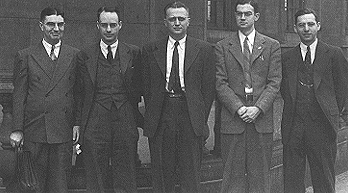 CERA's 1942 directors (left to right): Charles H. Brady, Charles A. Brown, George Krambles, Wallace M. Rogers, and Bernard L. Stone. For a larger view, click here. (Photo from Krambles-Peterson Archive) |
GK also continued to advocate "reducing the bulk". Some suggestions were cheap and simple, such as eliminating excess verbiage like "Park" and "Street" from the route names (making the "Douglas Park branch" into the "Douglas", "Garfield Park Line" into the "Garfield", "Lake Street Line" into the "Lake", as displayed on destination signs and other system graphics). Other suggestions were of a more substantial nature, such as closing closely-spaced stations and truncating, later abandoning the low revenue, high cost short branch lines such as the Kenwood, Stockyards, Normal Park, Humboldt Park, Niles Center, and Westchester Lines and the outermost portion of the Douglas Park branch. He managed diverse projects requiring close coordination of engineering, operation, and construction, such as the creation of a unified bus/rail/power Control Center. During his years at the CTA, he also worked on the engineering of maintenance and design of rapid transit rolling stock, third rail, overhead wire, traction power supply and distribution, lighting, supervisory control, communications, and auxiliary systems. Krambles had the ability to see the big picture on a project while still paying close attention to the minute details. He also helped to develop many managers and foreman in the CTA system, remembers former-CTA General Operations Manager Harold Geissenheimer. "He was personally involved in spotting and advancing people dedicated to making the CTA work."
One of the largest single projects that Krambles led and is perhaps one of those most associated with him was the development of the Skokie Swift. Rapid transit operations were suspended on the Niles Center branch in 1948 and the line was replaced with bus service, but the North Shore Line interurban continued to use the tracks until it ceased in January of 1963. Krambles did not want to see the interurban fade from existence (he was one of the chief planners behind a 1958 plan for the CTA to assume the services of the North Shore Line), but was unwilling to reinstate the old "L" service with its numerous local stops. So a novel plan was developed: the CTA applied to the U.S. Housing and Home Finance Agency for a grant to subsidize a new service on the old interurban tracks between Dempster and Howard. But the service would be a high-speed, nonstop shuttle service called the Skokie Swift, which began operation on April 20, 1964 to prove that urban mass transit could be modified to fit the suburban market. A large parking lot at the Dempster terminal allowed suburban commuters to drive to the station (which was located just off the Edens Expressway) and then take a fast, cheap, convenient "L" ride the rest of the way downtown. Krambles was involved in all aspects of the service's planning, from the design of the rolling stock to the overhead catenary and power distribution (including the development of the pan-trolley, itself based on research the Illinois Terminal had conducted years earlier) to the station facilities to the operations and schedules. The service was a success, producing a profit of $216,717 on revenues of just under $800,000 in its first two years of operation, far beyond expectations. The Skokie Swift was the first extension of the "L" since Insull's CRT finished the Westchester branch in 1930 (the 1958 Congress Line had simply replaced the old Garfield Park Line mile-for-mile) and it was a success. One of GK's fondest memories of the Swift was the measure of employee pride the new service generated. As part of the Skokie Swift project, Krambles was also able to find a second life for four of his favorite cars, the 5000-series units 5001-5004. GK had an admiration and love of the four articulateds that most everyone else regarded as the unwanted stepchildren of the CTA fleet. The passenger demands of the Swift quickly outstripped the single-unit 1-50s assigned to the line. Additional 1-50s were transferred to Skokie service to supplement cars 1-4, but still the demand grew. The high capacity of the 5000s attracted Krambles's attention and, after receiving an overhaul supervised by GK, the units emerged as cars 51-54 and served the Swift faithfully for 20 years, thanks to his interest in them.
As he did for the 5000s, Krambles found a second life for another set of CTA cars as well. In 1973, with the trolley wire on the Evanston Line was replaced with third rail, the last of the 1920s-era Cincinnati-built 4000-series cars were set to be retired. Although a number of them would be (and already had been) taken by museums, GK felt that a set should be retained by the CTA, restored externally to an older era, and decorated inside as a mobile museum. Choosing the last pair of 4000s to get an overhaul, cars 4271-4272, George had them brought to Skokie for restoration. He personally oversaw their overhaul and took great pride in the creation of the CTA's Historic Cars. More than any other, they were seen as GK's cars. Krambles understood the public relations value of the historic train as well. Frequently, it was used for part of the Saturday session of the CTA Technical Institute. There were several times where intended Skokie Swift revenue passangers were carried (along with CTA personnel and CTA Technical Institute attendees) from Dempster to Howard: If the cars were out at Skokie for the Institute and there were a few people on the platform waiting, after changing ends, it would pull into the station, open the doors and take what passengers there were to Howard just for that single, one-way trip. A ride on the "brown cars" never failed to elicit a positive reaction from the members of the public.
Thomas B. O'Connor served as General Manager of the CTA for nine years until 1973. But after his term, no single person was chosen to take over the CTA's chief operating position. Instead, a management committee was formed, which included Krambles, Milton Pikarsky, and three others. But in 1976, Krambles officially assumed the leadership of the CTA. Becoming General Manager in February and Executive Director (the new name for what was previously called the General Manager) in October, Krambles had risen up through the ranks from student engineer to head of Chicago's rapid transit system, the last CTA president to do so.
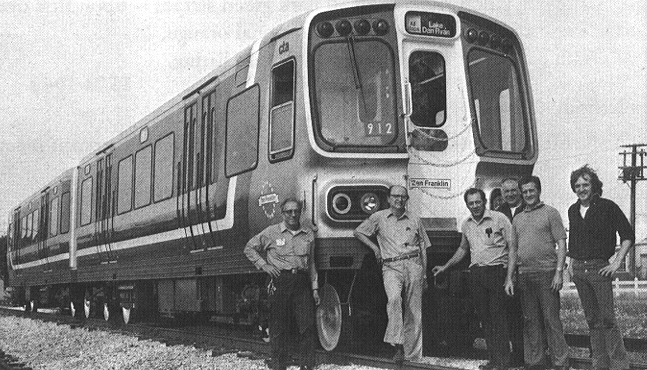 The people associated with the first Bicentennial car, the Benjamin Franklin, pose with car 1776 at Skokie Shops on October 5, 1974: (left to right) Ed Galek, CTA maintenance; George Krambles, General Operations Manager; Paul Venticinque, unit supervisor; Jan Broka, painter; Mitch Faczek, painter; and Frank Vukovics, electrician. For a larger view, click here. (Photo by Art Peterson) |
GK also had his hand in one of the more obscure schemes that was worn ever-so-briefly by 1-50 series car 50: RTA blue, orange, and brown striping confined to the car's belt rail. Car 50 received this paint scheme around 1977. It had a basic platinum mist body with charcoal through the windows, just like car 24 wore starting in 1974 (just without the orange belt rail). The RTA "ball" logos were stenciled on four of the upper sash windows (probably the ones adjacent to and inboard of the doorsets). GK took then-CTA Chairman James McDonough went up to see the car at Skokie Shops and he summarily rejected the design. McDonough didn't think the CTA should be advertising for the RTA (at the time there was some rivalry between the agencies). So, car 50 was restriped, with a red, white, and blue belt rail seen in a later variation of the scheme subbed for the RTA colors. Not even all of GK's ideas saw the light of day!
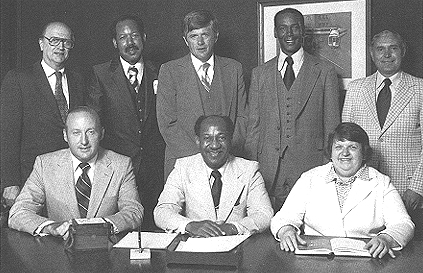 Executive Director George Krambles poses on August 1, 1979 with the CTA Board with whom he served most of his final year. Seated, left to right: former chairman James J. McDonough, Chairman Eugene M. Barnes, and Mathilda A. Jakubowski. Standing, left to right: Krambles, Howard C. Medley Sr., James P. Gallagher, Ernie Banks (yes, the baseball player), and Nick Ruggiero. For a larger view, click here. (Photo by the CTA) |
Two years later, Krambles would again prove his grace and talent under extreme pressure. In February 1979, Jane Byrne became mayor of Chicago and, in contrast to the policies of the Daley administration, she decided she would take a hard-line position against the city's labor unions. In the middle of the Christmas shopping season, the union CTA workers went on strike. Byrne decided to buck the union and ordered the CTA to operate limited service using nonunion management personnel. Recalls Chicago Tribune reporter (and author of Chicago Transit: An Illustrated History) David Young:
"I was sitting around the CTA control room around 8pm one night waiting for some news for tomorrow's paper when Harold Geissenheimer and George came up and said they were thinking about resuming service the next day on one of the rapid transit lines but wouldn't make the decision until about 11pm. So I said, "George, why do you want to run empty trains tomorrow?""What do you mean?" he asked.
"Well, if you wait until 11pm to make a decision, you'll blow the 10 O'Clock News and the deadlines for all the morning papers. So no one will know the trains are running."
He gave me a scowl of a look, then hurried off with Harold to huddle somewhere.
A few minutes later, he came back and said, "All the PR people have gone home. Who will write the release?"
"I will," I replied, thinking of how nice it would be to catch the 11:40 train home. So we scrounged up a couple of sheets of CTA stationary and I typed a release right there while George provided the details. We made a copy and faxed it to City News for distribution to all the media. I phoned the Tribune to dictate the story.
Some months later I asked George how he was able to get all the decisions made and details arranged in such a short time -- just a few minutes -- to make the media deadlines. "Once we made the decision on the announcement, Harold and I stayed up half the night arranging [management] crews and schedules," George replied.
George knew the system in such intimate detail he could make a decision like that with the confidence he could execute it in the wee hours of the morn."
The Amalgamated Transit Union had to give up its cost-of-living escalator. When the public and news media supported the city's position, the strike was short-lived.
Less than a year later, Krambles retired from the CTA in 1980. As CTA Executive Director, he had presided over sweeping changes in technology and operations, all while negotiating the complexities of Chicago politics. Recalls his nephew and former CTA employee Art Peterson, "The most sentimental memory I have of car 1 [the radio call sign Krambles used] is on the last day he worked for the CTA. Somehow I was listening to a CTA radio when Paul Christino took GK to the airport to board the plane to begin his consulting career in Buenos Aires. When they got to the airport, GK signed off his 43 years of service to the CTA and it predecessors with a simple 'Car 1 going 10-7 for the last time.' In CTA parlance, when you go 10-7, you're off duty."
In retirement, Krambles became an influential consultant to transit systems worldwide. He specialized in guidance for new start projects, solution of problems arising in mature properties, and peer review. Some of his consulting projects took him to Buenos Aires, Taiwan, Alberta, San Diego, Philadelphia and Seattle. He also worked on the Long Island to Grand Central line and NYCT inter-car barrier attachment in New York City. He consulted on several CTA projects as well, including the new Skokie Terminal facility on the Yellow Line.
GK was active in the American Public Transit Association and was inducted into the APTA's Transit Hall of Fame in 1995. He was also active in the International Union of Public Transport, the Western Society of Engineers, and the Advanced Transit Association and was the first representative of the transit industry to serve on the Executive Committee of the Transportation Research Board. For the Office of Technology Assessment of the US Congress, he chaired a panel which reviewed automated guideway transit and train control in rapid transit. He also provided expert testimony to legislative bodies on funding a regulatory matters.
Research and education continued to be cornerstones of Krambles's transit interests long after retirement from the CTA. He continued to document not only the CTA but other transit systems as well, accumulating what is believed to be the largest private collection of transit photographs and slides. He continued to write and lecture, contributing to the body of knowledge and history on public record. He also founded the George Krambles Transit Scholarship Fund, a not-for-profit corporation that awards grants to assist men and women in their undergraduate or graduate studies in pursuit of professional careers in the transit industry. The GKTSF was founded on his retirement from CTA. As much as anything, the formation of the fund was a reaction to the situation George had found in his own college career back in the 30's. At that time, only two schools offered any sort of railway engineering program. These would later be discontinued owing to low participation. Throughout his working career, GK saw that the transit industry was not attracting the new graduates that it needed.
George Krambles expresses
his appreciation for the surprise birthday party held on
March 11, 1990 on the occasion of his 75th birthday. Here,
he is in the trainman's room at 54th
Avenue, where George
was showered with gifts and applause. For a larger view,
click here. GK's nephew Art Peterson
provides at-seat drink service on the 80th birthday charter
as guests await their turn to enjoy dinner. For a larger
view, click here.
(Photo by Phil
Cioffi)
The enormous respect and affection that Krambles had acquired
over the years from his friends, family and peers was twice
demonstrated with massive birthday galas. In March 1990, one week
after the 75th anniversary of his birth, George was lured to the
O'Hare station on a pretext;
awaiting him was a two-car charter consisting of historic cars
6101-6102 (which CTA forces had scrubbed inside and out for the event
after a recent repainting), a group of his closest family, friends,
and associates, and a catered meal. George's nephew Art Peterson
coordinated the affair, which was limited to only 80 guests due to
the overwhelming response from George's legions of friends and to
give folks ample room to make their way to and from the buffet. The
charter ran in on the West-Northwest Route and out the Douglas branch
to 54th Terminal. There,
the party adjourned to the trainmen's room for ceremonies, including
the presentation of gifts. Later, the charter went to the end of the
Congress branch for photo opportunities before returning to River
Road and O'Hare to
discharge the passengers. It was a well-deserved tribute to a transit
professional, one that was given an encore performance five years
later
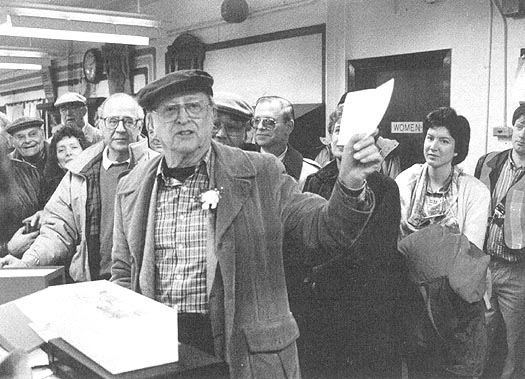
on GK's 80th birthday. In March 1990, another charter train
party was held to honor George. Some of the details had changed --
three 1-50 series PCCs
(cars 43, 44, and 48) stood in for 6000-series
car 6101-6102 (which had been sent off to the Fox
River Trolley Museum) and a "dinner train" was run instead of its
late lunch equivalent five years earlier -- but the scenario was more
or less the same. Once again, Krambles' family and friends gathered
at O'Hare station where the
train departed with a Greek-style buffet served aboard. The charter
traveled downtown on the Blue Line and west out the Douglas branch.
Replicating the party five years earlier, the train brought the
guests and guest of honor to the trainman's room at 54/Cermak
for the presentation of gifts and memorabilia. It was more food and
drink aboard the train as the charter ran out to Desplaines
on the Congress branch, then back to Rosemont
and O'Hare for farewells. Art
Peterson arranged the affair again, with extensive and enthusiastic
cooperation from the CTA. Even 15 years after his retirement from the
CTA, Krambles still had the respect, admiration, and affection of
many people. A feature of both of these trips was the thrill of
riding the train with GK in the motorcab, providing his trademark
fast, safe and comfortable ride!
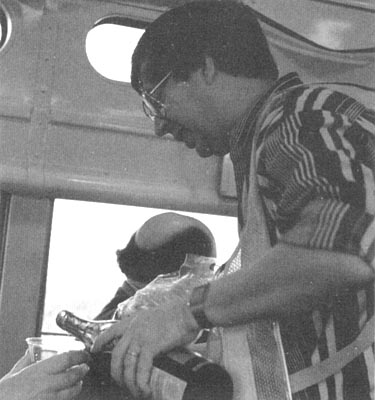
Electric railroading lost a giant when George Krambles died November 24, 1999 in Oak Park, IL, as he attempted to recover from open-heart surgery. He was 84. William D. Middleton, fellow author in the transit field, said Krambles was "a towering figure within the transit industry and among electric railway enthusiasts alike for well over a half-century. He always found time to share his encyclopedic knowledge of the electric railway industry with others of like mind, and he was generous with the fruits of his extraordinary collection."
The George Krambles Transportation Scholarship Fund, from which $100,000 has been awarded thus far, continues to help young men and women follow in GK's footsteps. For more information or to contribute, write the George Krambles Transportation Scholarship Fund at P.O. Box 425, Lake Forest, IL 60045-0425.
![]()
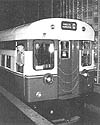 |
krambles02.jpg
(48k) |
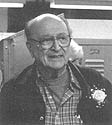 |
krambles03.jpg
(34k) |
 |
krambles09.jpg
(43k) |
 |
krambles10.jpg
(61k) |
I would like to thank Art Peterson, George Krambles' nephew, for graciously and repeatedly contributing a great deal of information for this biography.
|
|
SOURCES: